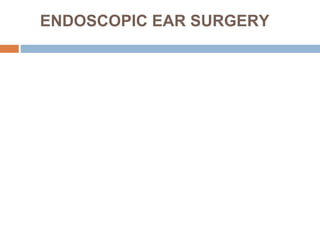Endoscopic ear surgery has progressed significantly over the past century alongside improvements in microscopy and endoscopy. While microscopy revolutionized ear surgery in the 1950s-60s by enabling binocular visualization, endoscopy offers additional advantages for procedures with narrow surgical corridors like the external auditory canal. These include a wider field of view around corners and the ability to perform surgery using only the ear canal as an access point. This preserves normal anatomy and decreases the need for bone removal. The 1990s saw early adoption of endoscopy for procedures like second look mastoidectomies. Its use expanded in the 2000s as more surgeons incorporated the techniques. Today, endoscopy provides an alternative to microscopic visualization for select otologic











































































